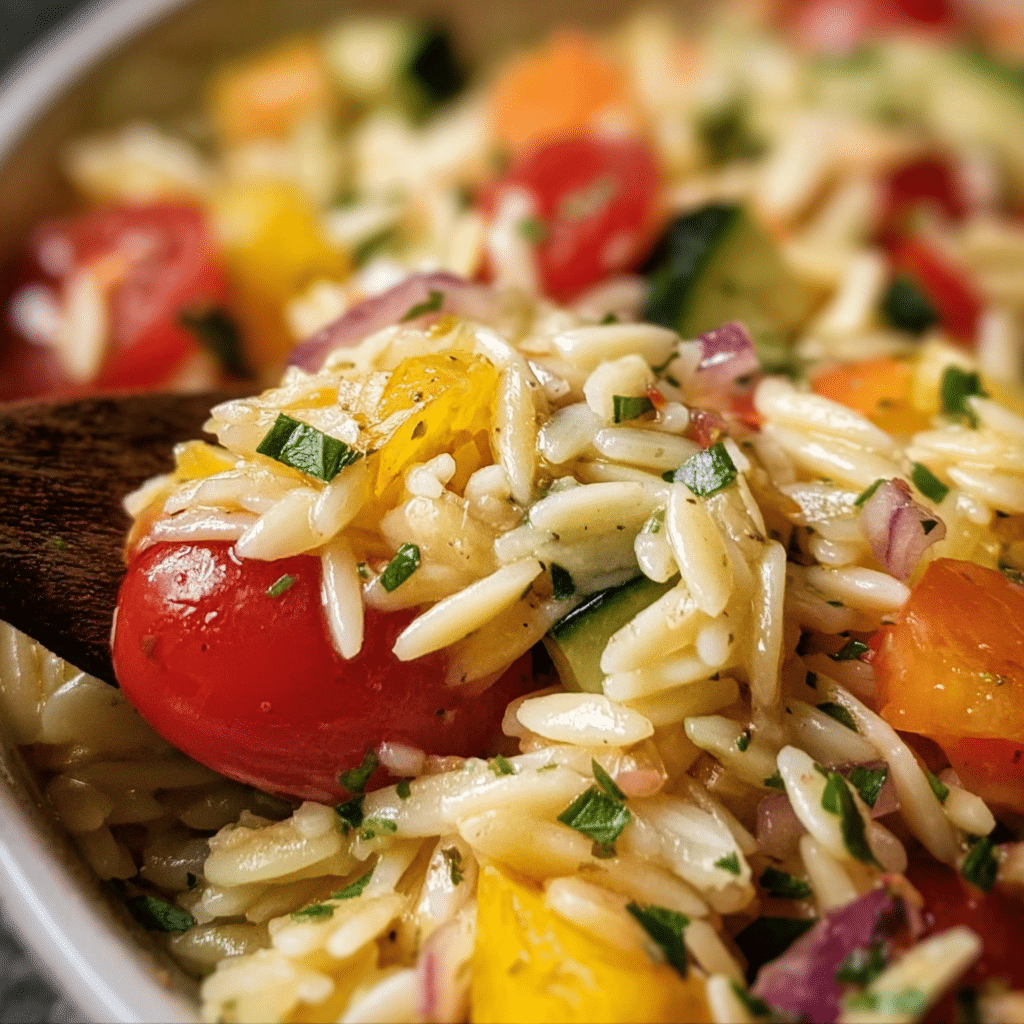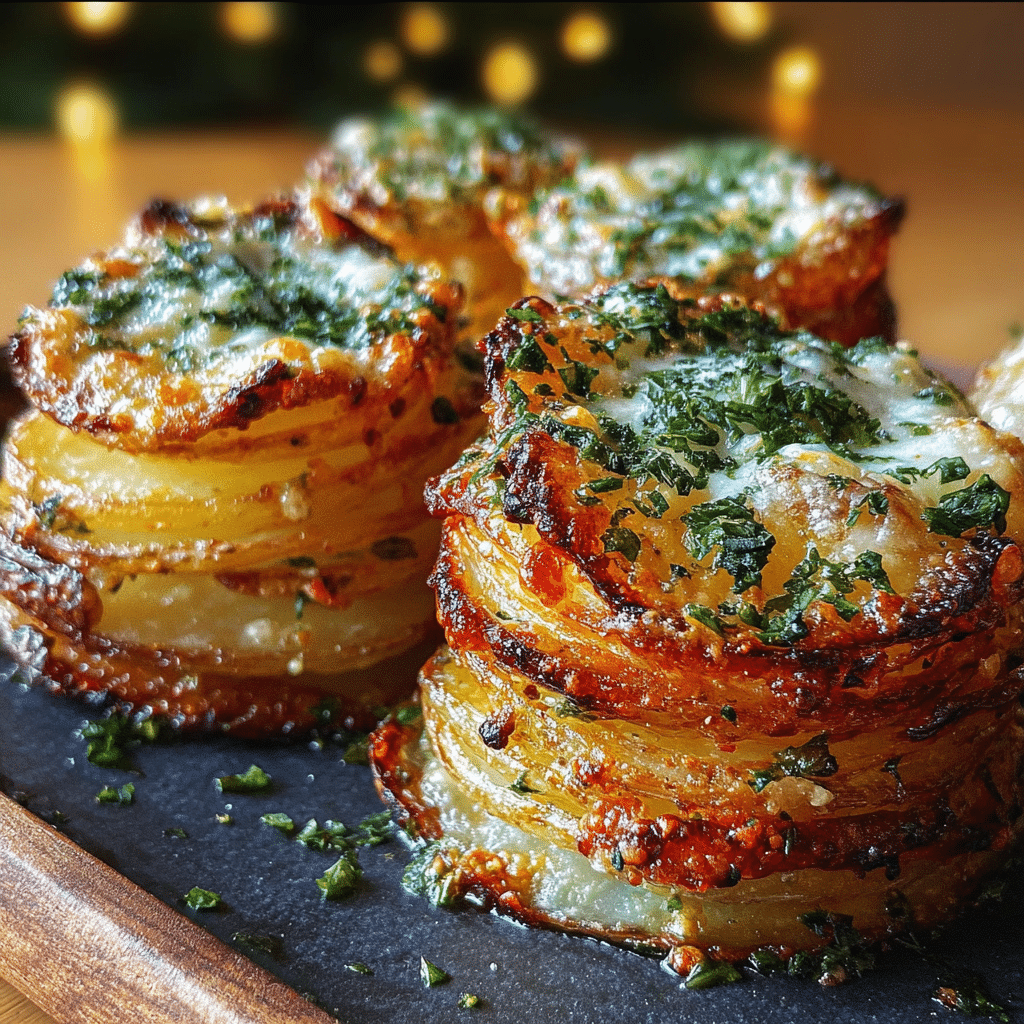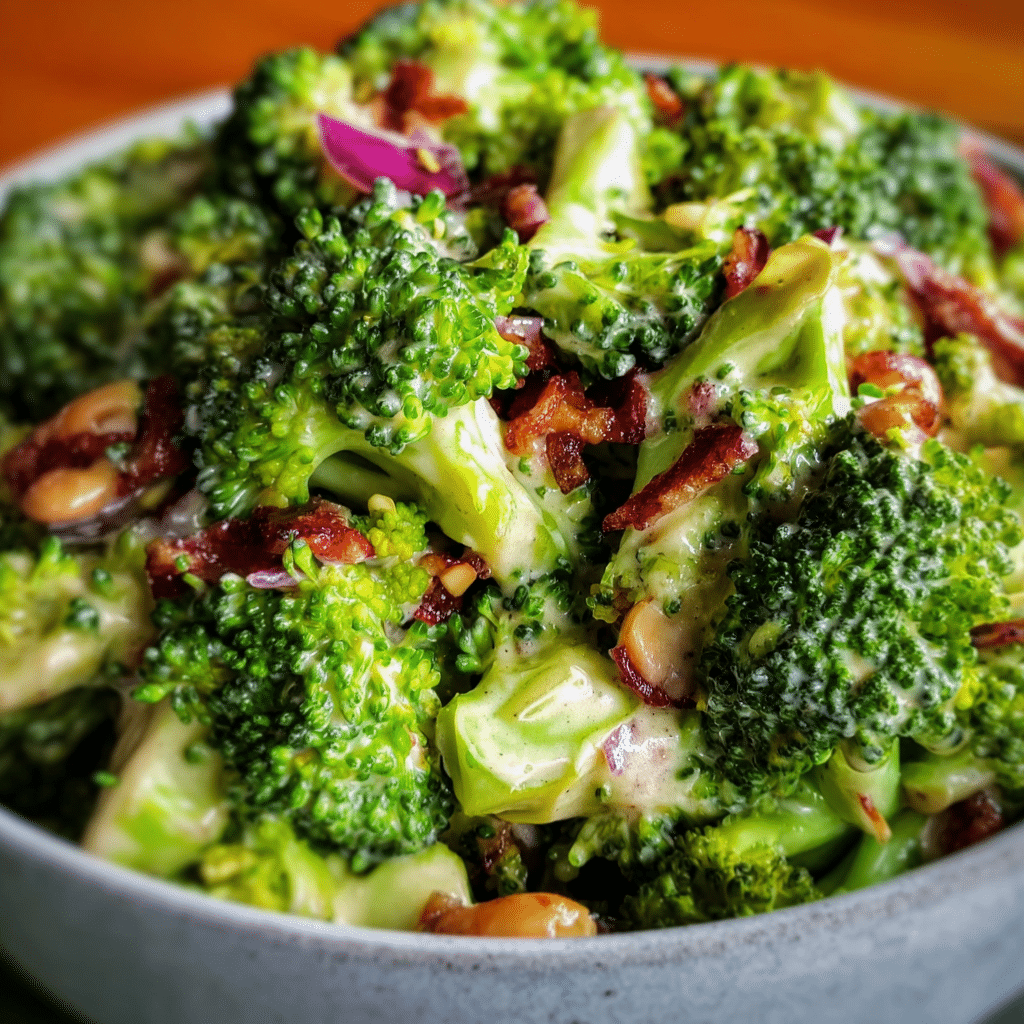High protein stuffed peppers are not just a meal; they are a comforting embrace on a chilly evening, a warm reminder of home-cooked goodness, and a canvas for culinary creativity. I first stumbled upon this delightful dish during a particularly hectic week when my family was juggling work commitments and school activities. It was a Sunday afternoon, and I was rifling through my pantry, desperate to create something wholesome yet simple. I found a few bell peppers, some leftover quinoa, and a smattering of spices. With a sprinkle of determination and a dash of inspiration, I whipped up what would become a family favorite: high protein stuffed pepper soup.
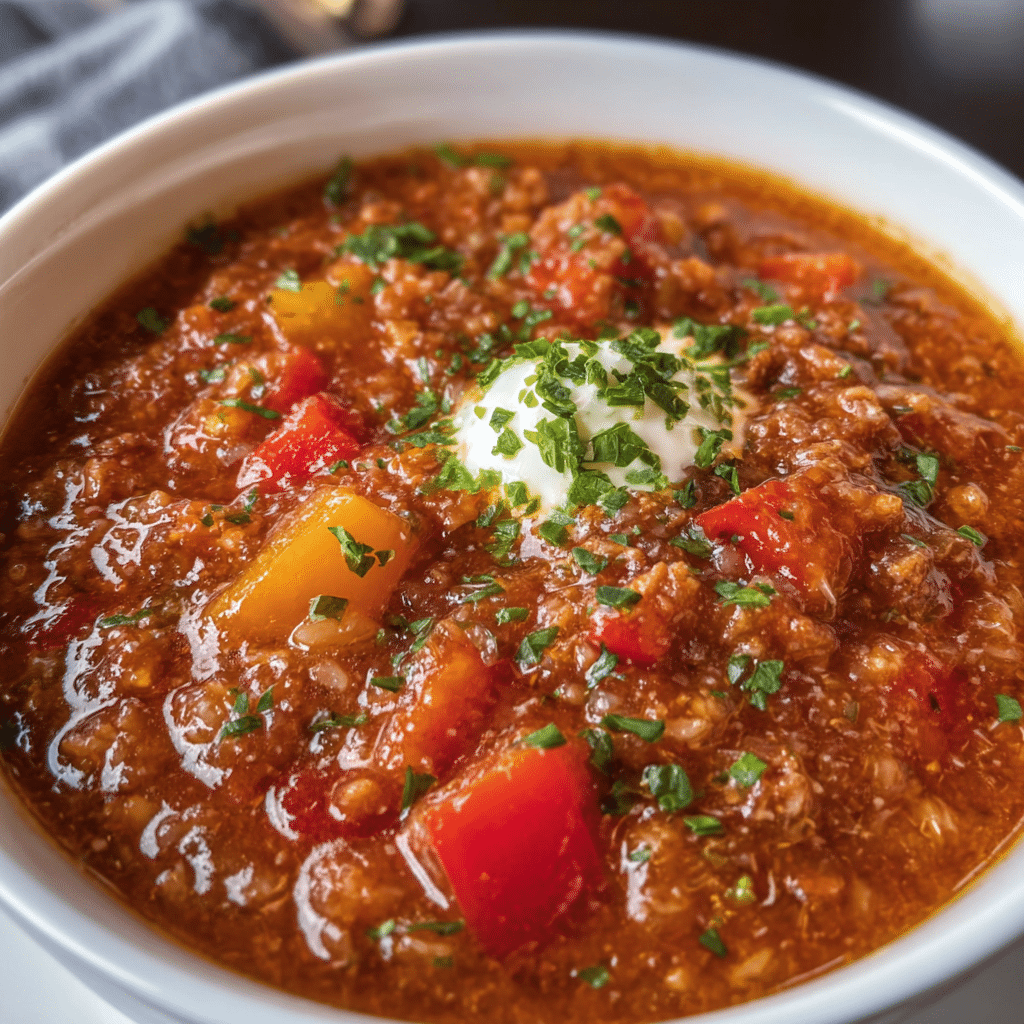
This recipe is special because it transforms the classic stuffed pepper into a warm, hearty soup, perfect for any time of year. The vibrant colors of the peppers dance in the pot, creating a visual feast, while the combination of protein-rich ingredients makes it a nutritious option for busy families. As I stirred the pot, the aroma wafted through my kitchen, beckoning my children like a siren’s call. They peeked in, their eyes lighting up at the sight of the bubbling broth, and I knew I had struck gold.
The Story Behind This Recipe
The origins of stuffed peppers can be traced back centuries, gracing tables in various cultures around the globe. From the Mediterranean to Latin America, each region has its unique take on this beloved dish. However, it wasn’t until I decided to merge my love for traditional stuffed peppers with the convenience of a soup that the magic truly happened. This high protein stuffed pepper soup combines the essence of stuffed peppers with the comforting qualities of soup, making it a unique twist on a classic.
Moreover, this recipe is inherently adaptable. On busy weeknights, when time is of the essence, this dish allows for a quick assembly of ingredients that can simmer on the stovetop or slow-cook in a crockpot. It’s perfect for busy families who crave nutritious meals without the fuss. Each spoonful is packed with flavor, warmth, and a delightful crunch from the peppers, creating a dish that feels both hearty and light.
Seasonally, this soup shines during the cooler months, when bell peppers are at their peak and can be found in a kaleidoscope of colors. The vibrant hues not only make the dish visually appealing but also elevate your mood on dreary days. I often find myself making a big batch in the fall, savoring each bowl while reminiscing about cozy evenings spent with loved ones, wrapped in blankets and sharing stories around the dinner table.
This dish holds a special place in my heart; it’s more than just food. It represents family traditions, the joy of cooking together, and the laughter that fills the kitchen. The simple act of chopping vegetables and stirring the pot becomes a way to connect and share moments. It’s a reminder that even during the busiest times, we can take a moment to nourish our bodies and our souls.
In this article, I promise to guide you through the ins and outs of creating your own high protein stuffed pepper soup. You’ll learn about the best ingredients to use, how to customize the recipe to your family’s tastes, and tips for making it ahead of time. Whether you’re a seasoned cook or a beginner in the kitchen, this dish will become a staple in your home, bringing joy and satisfaction to your dining table.
The Rich History and Cultural Significance of high protein stuffed
The rich history and cultural significance of high protein stuffed peppers can be traced back to ancient civilizations. Bell peppers, a staple in many cuisines around the world, were first cultivated in Central and South America over 6,000 years ago. They quickly spread to Europe and Asia, where they adapted to local tastes and cooking methods. The concept of stuffing vegetables is not new; it has been a culinary tradition in various cultures for centuries, often using whatever ingredients were available. This adaptability has led to the evolution of what we now enjoy as high protein stuffed pepper soup, a dish that captures the essence of many traditional recipes.
Origins and History
Throughout history, the art of stuffing food has allowed communities to utilize every part of their harvest, minimizing waste and maximizing flavor. In Mediterranean countries, for example, stuffed peppers are often filled with rice, ground meats, and spices, creating a hearty meal that reflects the region’s agricultural bounty. In contrast, Middle Eastern variations might include lamb, herbs, and spices, all wrapped in grape leaves or peppers, highlighting the diverse global interpretations of this dish.
As I researched the origins of stuffed peppers, I discovered that they have been a canvas for culinary expression across cultures. In Italy, stuffed peppers are often baked with marinara sauce, while in Mexico, they’re commonly filled with cheese and spices. Each variation tells a story of place, culture, and tradition, and this is what makes high protein stuffed pepper soup so special. It allows you to take these rich histories and create something new, merging flavors and techniques from different culinary traditions.
Cultural Significance
Stuffed peppers often grace holiday tables and family gatherings, symbolizing abundance and togetherness. In my own family, we have adopted this dish as a staple for gatherings and celebrations, a way to bring everyone together around a shared love for food. The act of preparing the soup becomes an event in itself; I often find my children helping to chop vegetables or stir the pot, turning cooking into a family bonding experience. It’s a dish that encourages storytelling, laughter, and connection—elements that are crucial in any cultural celebration.
As the recipe has evolved, it has become more than just a traditional dish; it now embodies modern dietary needs and preferences. The high protein aspect of this soup appeals to health-conscious families, making it an ideal option for those looking to increase their protein intake without sacrificing flavor. The addition of quinoa, beans, or lean meats not only enhances the nutritional profile but also makes it a filling meal that satisfies even the heartiest of appetites.
Nutritional Benefits
High protein stuffed pepper soup is not only delicious but also brimming with nutritional benefits. Bell peppers themselves are rich in vitamins A and C, antioxidants that support immune function and skin health. When combined with protein sources like lean turkey, beans, or quinoa, this soup becomes a powerhouse of nutrition. It provides a balanced meal that keeps you full and fueled without the heaviness that some traditional stuffed pepper recipes may carry.
Moreover, the versatility of this dish means you can easily cater to various dietary preferences, including vegetarian, vegan, or gluten-free options. As more people become aware of the importance of nutrition, high protein stuffed pepper soup stands out as an inclusive meal choice that can fit into anyone’s lifestyle. It’s a dish that not only nourishes the body but also warms the heart, making it a cherished recipe in kitchens everywhere.
In conclusion, the rich history and cultural significance of high protein stuffed peppers offer a glimpse into the traditions of different communities while allowing for personal expression in the kitchen. This soup is not just a meal; it’s a celebration of flavors, stories, and togetherness, making it a perfect addition to any family’s dinner rotation.
Essential Ingredients for Perfect high protein stuffed
When it comes to creating a comforting bowl of High Protein Stuffed Pepper Soup, the ingredients you choose play a pivotal role in shaping the flavor, texture, and nutritional value of the dish. This recipe is not only delicious but also packed with protein, making it an excellent choice for those looking to maintain or build muscle while enjoying a hearty meal. Below, I will share an extensive list of ingredients along with insights into their importance, quality indicators, and tips for sourcing the best options.
Essential Ingredients
- Bell Peppers (4 large, mixed colors) – The star of the show! Bell peppers add sweetness and a beautiful color to the soup. Choose firm, shiny peppers without blemishes.
- Ground Turkey or Beef (1 pound) – A high protein option that adds richness to the soup. Select lean cuts for a healthier choice.
- Onion (1 medium, diced) – Provides a foundational flavor that enhances the overall taste. Look for a firm onion with dry, papery skin.
- Garlic (3 cloves, minced) – Adds aromatic depth and a touch of spiciness. Fresh garlic is always best; choose bulbs that feel firm and are free of soft spots.
- Tomato Sauce (1 can, 15 ounces) – This forms the base of the soup and adds acidity. Opt for organic varieties when possible.
- Low-Sodium Chicken or Vegetable Broth (4 cups) – Used to adjust the soup’s consistency. Look for low-sodium options to control your salt intake.
- Quinoa or Brown Rice (1 cup, cooked) – This grain adds texture and further boosts the protein content. Consider using whole grains for added fiber.
- Cumin (1 teaspoon) – A warm spice that complements the other flavors beautifully. Freshly ground cumin offers the best flavor.
- Chili Powder (1 teaspoon) – Adds a subtle kick. Use a blend that suits your heat preference.
- Salt and Pepper (to taste) – Essential for enhancing and balancing flavors.
- Fresh Cilantro or Parsley (for garnish) – A fresh herb that adds brightness to the finished dish.
Each ingredient in this High Protein Stuffed Pepper Soup has a specific role, contributing not just to the flavor but also to the nutritional profile. For example, bell peppers are an excellent source of vitamins A and C, while lean ground turkey provides protein without excessive fat. The quinoa or brown rice adds complex carbohydrates, making this soup a balanced meal.
Print
High Protein Stuffed Recipe
Ingredients
- 1 lb extra lean ground beef or turkey cooked and drained
- ½ yellow onion diced (about ½ cup)
- 1 green bell pepper diced
- 1 red bell pepper diced
- 14 oz can diced tomatoes with juices, about 1.75 cup
- 3 cups low sodium beef broth
- 1 +¾ cups tomato sauce
- 2 teaspoon dried oregano
- 1.5 teaspoon garlic powder
- Salt and black pepper to taste
- 1 tablespoon worcestershire sauce
- 3 cups riced cauliflower can be frozen
- 540 mL can lentils rinsed and drained
- Shredded cheddar cheese optional for topping
Instructions
-
In a 6 quart slow cooker, add cooked ground beef, diced yellow onion, green pepper, red pepper, diced tomatoes (and their juices), beef broth, tomato sauce, oregano, garlic powder, salt and pepper (to taste), worcestershire, riced cauliflower and lentils.
-
Cover and place on HIGH for 3-4 hours or LOW for 6-8 hours.
-
After the soup has cooked and the vegetables are tender. Adjust spices to desired taste. Serve and top with shredded cheese (optional).
Shopping Tips
When shopping for ingredients, consider the following tips to ensure you select the best options:
- Freshness: Always look for the freshest produce, especially for vegetables like bell peppers and onions. Freshness not only affects flavor but also nutritional value.
- Organic vs. Conventional: Organic produce typically has fewer pesticides and is often fresher. If your budget allows, opt for organic bell peppers and other vegetables.
- Quality Meat: For ground turkey or beef, look for lean options with minimal additives. If possible, buy from local butchers or trusted brands that prioritize quality.
- Bulk Buying: Consider purchasing grains like quinoa or brown rice in bulk, which can be more economical and reduce packaging waste.
Substitutions and Alternatives
Dietary restrictions or preferences can easily be accommodated in this recipe. Here are some substitution ideas:
- Protein Alternatives: For a vegetarian option, replace ground turkey or beef with lentils or plant-based meat alternatives. Both options provide ample protein.
- Grain Alternatives: If you’re gluten-free, substitute brown rice with cauliflower rice or quinoa.
- Vegetable Variations: Feel free to mix in other vegetables such as zucchini, corn, or spinach for added nutrition and flavor.
Understanding how to store your ingredients is also crucial for maintaining their freshness:
- Bell Peppers: Store in the refrigerator’s crisper drawer for up to a week. Avoid washing them until you’re ready to use them.
- Ground Meat: Always freeze if you’re not using it within a day or two. Use freezer bags to prevent freezer burn.
- Grains: Store dried grains in a cool, dark place, preferably in airtight containers to keep them fresh.
In summary, the success of your High Protein Stuffed Pepper Soup lies in the quality and selection of your ingredients. By choosing fresh, high-quality components and considering substitutions for dietary needs, you can create a delicious and nutritious meal that fits your lifestyle. Happy cooking!
Detailed Step-by-Step high protein stuffed Cooking Instructions
Now that we’ve gathered all the essential ingredients for our High Protein Stuffed Pepper Soup, it’s time to dive into the cooking process. This step-by-step guide will ensure that you achieve a flavorful and hearty soup that not only satisfies your taste buds but also nourishes your body. Cooking is an art as much as it is a science, and I believe that understanding each step can significantly enhance your culinary experience.
Preparation Steps
- Mise en Place: Begin by preparing all your ingredients. Dice the onion, mince the garlic, and chop the bell peppers into bite-sized pieces. Cook your quinoa or brown rice according to package instructions, as this will save time later. Having everything prepped and ready to go will make the cooking process smoother and more enjoyable.
- Cook the Meat: In a large pot or Dutch oven, heat a tablespoon of olive oil over medium heat. Once hot, add the ground turkey or beef. Use a wooden spoon to break it apart and brown it evenly. This should take about 5-7 minutes. Ensure the meat is fully cooked, with no pink remaining.
- Add Aromatics: Once the meat is browned, add the diced onion and minced garlic to the pot. Stir well and cook for another 3-4 minutes until the onions are translucent and fragrant. This step builds the aromatic base of your soup.
- Incorporate Bell Peppers: Add the chopped bell peppers to the pot. Sauté for an additional 5 minutes, allowing the peppers to soften slightly. Their natural sweetness will begin to infuse into the soup.
Cooking Process
- Add Tomato Sauce and Broth: Pour in the can of tomato sauce and the chicken or vegetable broth. Stir to combine, scraping the bottom of the pot to release any flavorful bits stuck to it. This adds depth to the soup.
- Season the Soup: Add the cooked quinoa or brown rice to the pot, along with cumin, chili powder, salt, and pepper. Stir well to incorporate all the ingredients. Bring the soup to a gentle boil, then reduce the heat to low.
- Simmer: Cover the pot and let the soup simmer for 20-25 minutes. This allows the flavors to meld beautifully. Stir occasionally, and if it seems too thick, add more broth or water to reach your desired consistency.
- Taste and Adjust: After simmering, taste your soup. This is the perfect moment to adjust the seasonings. Add more salt, pepper, or spices as needed. If you like a bit of heat, consider adding a pinch of cayenne pepper.
Final Assembly
- Serve: Once you’re satisfied with the flavor, it’s time to serve your High Protein Stuffed Pepper Soup. Ladle generous portions into bowls and garnish with fresh cilantro or parsley. This adds a burst of color and freshness.
- Enjoy: Take a moment to appreciate your creation. The aroma, the color, the warmth – all of it combines to create a heartwarming meal. Enjoy your soup with crusty bread or a side salad for a complete meal.
- Storage Tips: If you have leftovers, let the soup cool to room temperature before transferring it to airtight containers. It can be stored in the refrigerator for up to 4 days or frozen for up to 3 months. Just be aware that the texture of the bell peppers may change slightly upon reheating.
- Common Mistakes to Avoid: One common mistake is overcooking the vegetables. You want them tender but not mushy. Additionally, don’t skip the tasting step; under-seasoned soup can be a disappointment. Lastly, be mindful of cooking times for the grains; they should be cooked separately before adding them to the soup.
In conclusion, making High Protein Stuffed Pepper Soup is an enjoyable and rewarding experience. By following these detailed instructions and keeping a few tips in mind, you can create a dish that is not only nourishing but also bursting with flavor. Cooking time is approximately 30 minutes, making it a perfect weeknight meal that doesn’t compromise on taste or nutrition. Enjoy your culinary journey!
Professional Tips and Techniques for high protein stuffed
When it comes to creating a delightful bowl of high protein stuffed pepper soup, mastering some professional tips and techniques can elevate your dish from ordinary to extraordinary. Whether you’re a beginner or a seasoned chef, these insider secrets will help you navigate the kitchen with confidence.
Professional Techniques
One of the first things to consider when preparing high protein stuffed pepper soup is the choice of peppers. The type of bell pepper you use can greatly affect the flavor profile of your soup. I prefer using a mix of colors—red, yellow, and green—not just for their vibrant appearance but also for their varying levels of sweetness and bitterness. Roasting the peppers before adding them to the soup can enhance their natural flavors, giving the dish a deeper, more complex taste.
Additionally, if you want to add a unique twist, consider incorporating different types of peppers such as poblano or Anaheim, which can introduce a mild heat to the soup. When chopping your veggies, aim for uniform sizes to ensure even cooking. This is especially important when you’re working with ingredients like onions, garlic, and tomatoes, which form the base of the soup. A good chef’s knife and a cutting board are essential tools in this process. A sharp knife makes the task easier and safer, allowing for greater precision.
Another technique for achieving a rich flavor is the method of sautéing your aromatics. Start by heating olive oil in your pot and adding chopped onions, garlic, and spices like cumin or smoked paprika. Allow these ingredients to cook until they become fragrant and translucent. This step is often overlooked, but it’s vital for building the flavor foundation of your high protein stuffed pepper soup.
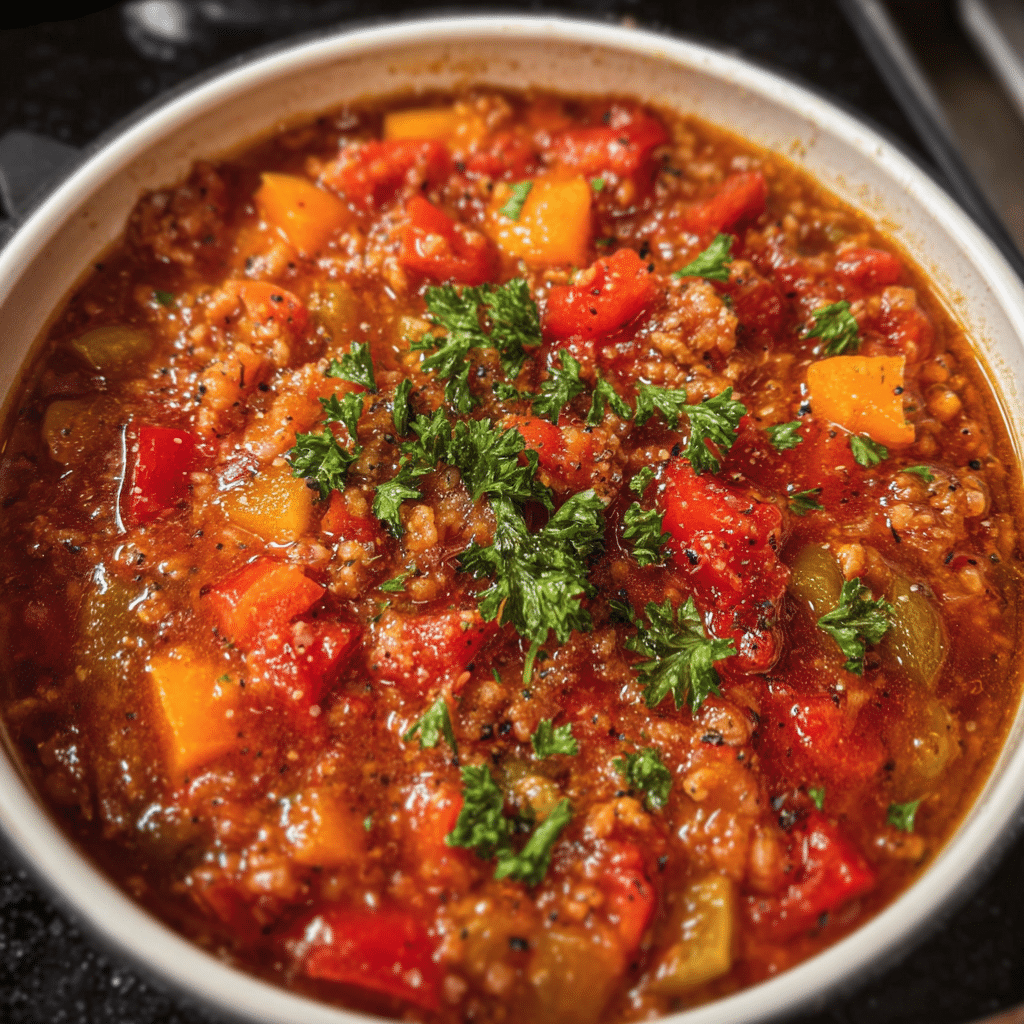
Troubleshooting Guide
Even the most experienced cooks encounter challenges. One common issue with high protein stuffed pepper soup is that it can sometimes turn out too watery. To combat this, ensure that you’re using the right ratio of broth to solid ingredients. If you find yourself with a soupy mess, consider thickening it with a cornstarch slurry or adding pureed beans for extra protein and texture.
If your soup lacks depth, don’t hesitate to adjust the seasoning. A pinch of salt or a splash of vinegar can dramatically enhance flavors, bringing out the natural sweetness of the peppers and the savory notes of the protein. Taste your soup as you go; it’s one of the best parts of cooking!
Make-Ahead and Meal Prep Strategies
One of the beauties of high protein stuffed pepper soup is its ability to be made in advance. Prepare a large batch on a Sunday, and you’ll have delicious meals ready for the week ahead. Store leftovers in airtight containers in the refrigerator for up to four days, or freeze portions for later use. When reheating, add a splash of broth to maintain the desired consistency, as the soup may thicken during storage.
If you’re looking to scale the recipe up or down, it’s as simple as adjusting the quantity of peppers and the other ingredients proportionally. Keep in mind that the cooking time may change slightly depending on the size of your batch, so be sure to monitor the soup as it simmers.
Presentation Tips
Presentation can make a significant impact on how your dish is received. For serving your high protein stuffed pepper soup, consider using wide, shallow bowls that allow the vibrant colors of the soup to shine. Top each bowl with a dollop of sour cream or Greek yogurt, and sprinkle fresh herbs like cilantro or parsley for a pop of color and flavor.
For an extra special touch, you might even serve the soup in halved bell peppers, creating an impressive and edible serving vessel. This not only enhances the visual appeal but also ties back to the theme of stuffed peppers! Pair your soup with a light, crisp white wine or a refreshing sparkling water with a slice of lemon to cleanse the palate.
In conclusion, with these professional tips and techniques in your culinary arsenal, your high protein stuffed pepper soup will not only be nutritious but also a feast for the eyes and the tastebuds. Remember that cooking is as much about experimentation as it is about following recipes. Enjoy the process and don’t be afraid to make it your own!
Creative Variations and Adaptations of high protein stuffed
Exploring creative variations and adaptations of high protein stuffed pepper soup can turn a simple recipe into a culinary adventure. The flexibility of this dish allows for seasonal ingredient swaps, international flavors, and dietary modifications that make it suitable for any palate.
Seasonal Variations
As the seasons change, so too can the ingredients in your high protein stuffed pepper soup. In the summer months, I love incorporating fresh corn and zucchini, which add a sweet crunch and vibrant color to the soup. These vegetables not only enhance the flavor but also increase the nutritional value. In the fall, consider adding roasted butternut squash or sweet potatoes for a heartier base, bringing warmth and a touch of sweetness that pairs beautifully with the spices.
Winter variations can include hearty greens like kale or Swiss chard, which not only provide additional nutrients but also make the soup more filling. During the spring, fresh herbs such as basil or dill can be added just before serving to bring brightness to the dish. The beauty of high protein stuffed pepper soup lies in its adaptability to whatever ingredients are at their peak freshness.
Dietary Adaptations
One of the best aspects of high protein stuffed pepper soup is its ability to accommodate various dietary preferences. For those following a keto diet, swap out traditional rice for cauliflower rice or even quinoa, which has a higher protein content. If you’re looking to make the soup vegan, replace ground meat with lentils, chickpeas, or a plant-based meat alternative. These substitutions not only make the dish suitable for vegan diets but also add a unique texture and flavor.
For those with gluten sensitivities, ensure that any broth or sauces used are certified gluten-free, and consider using brown rice or gluten-free pasta as a filler. The options are virtually endless, making high protein stuffed pepper soup a versatile choice for family gatherings or meal prep.
Creative Twists
To give your high protein stuffed pepper soup an international flair, consider adding ingredients from different cuisines. For a Mexican twist, incorporate black beans, corn, and spices like chili powder and cumin. Top it off with avocado and cilantro for that authentic flavor. Alternatively, if you’re in the mood for Italian, add diced tomatoes, Italian sausage, and a sprinkle of parmesan cheese for a comforting, hearty meal.
If you want to explore different cooking methods, try using a slow cooker or Instant Pot. These appliances can create a depth of flavor that simmers all day, making it an easy set-it-and-forget-it option. Simply add all your ingredients, set the timer, and let the cooker do the work for you. The slow cooking method also allows the flavors to meld beautifully, resulting in a deeply satisfying soup.
Lastly, don’t forget about the leftovers! High protein stuffed pepper soup can be transformed into a delicious pasta dish or used as a filling for burritos or tacos. The possibilities are endless, ensuring that you make the most out of your culinary creations.
In conclusion, embracing creativity in high protein stuffed pepper soup can lead to an exciting variety of flavors and textures. Whether you’re following dietary restrictions or simply want to experiment with seasonal produce, this dish is a canvas for your culinary artistry. So grab your apron, and let your imagination guide you through your next cooking adventure!
Storage, Reheating, and Meal Prep for high protein stuffed
When it comes to preparing a delicious pot of high protein stuffed pepper soup, one of the most rewarding aspects is knowing that you can enjoy it multiple times throughout the week. Whether you’re a busy parent, a student, or simply someone who enjoys cooking in batches, understanding the best storage, reheating, and meal prep techniques can truly elevate your cooking experience. Let’s dive deep into the details of storage and meal prep for this delightful dish.
Short-term Storage
Once you’ve made a big batch of high protein stuffed pepper soup, proper short-term storage is key to preserving its flavor and nutritional benefits. First, allow the soup to cool completely before transferring it to your storage containers. This step is crucial as placing hot food directly into the refrigerator can raise the temperature inside, potentially compromising food safety.
I recommend dividing the soup into individual serving portions using airtight containers. This not only makes it easy to grab a meal on the go but also helps in maintaining the soup’s integrity. Glass containers are an excellent option for storage, as they do not retain odors and are microwave safe, making reheating a breeze. If you’re using plastic containers, ensure they are BPA-free to avoid leaching chemicals into your food.
In the refrigerator, your high protein stuffed pepper soup can last for about 4 to 5 days. Make sure to label your containers with the date to keep track of freshness. When you’re ready to enjoy a bowl, simply take it out, give it a stir, and reheat it!
Freezing and Long-term Storage
If you’re looking to extend the shelf life of your high protein stuffed pepper soup even further, freezing is an excellent option. Freezing not only preserves the flavors but also makes for a convenient meal solution on busy days. To freeze the soup, follow the cooling instructions mentioned earlier. Once cooled, portion the soup into freezer-safe bags or containers, leaving some space for expansion. One trick I’ve learned is to lay the freezer bags flat in the freezer; this not only saves space but also allows for faster thawing.
When properly stored, frozen high protein stuffed pepper soup can last up to 3 months in the freezer. Be sure to label your containers with both the contents and the date. When you’re ready to use it, you can either thaw it in the refrigerator overnight or use the microwave for a quicker option. Just remember, the soup may separate slightly upon thawing, so a good stir will help bring it back together.
Reheating Best Practices
Reheating your high protein stuffed pepper soup correctly is essential to enjoying it just as much as the first time. If you’ve stored it in the refrigerator, you can simply reheat it on the stovetop over medium heat, stirring occasionally until it’s heated through. If you’re in a rush, the microwave is a great option as well. Transfer your serving to a microwave-safe bowl, cover it loosely with a lid or a paper towel, and heat in 30-second intervals, stirring in between to ensure even heating.
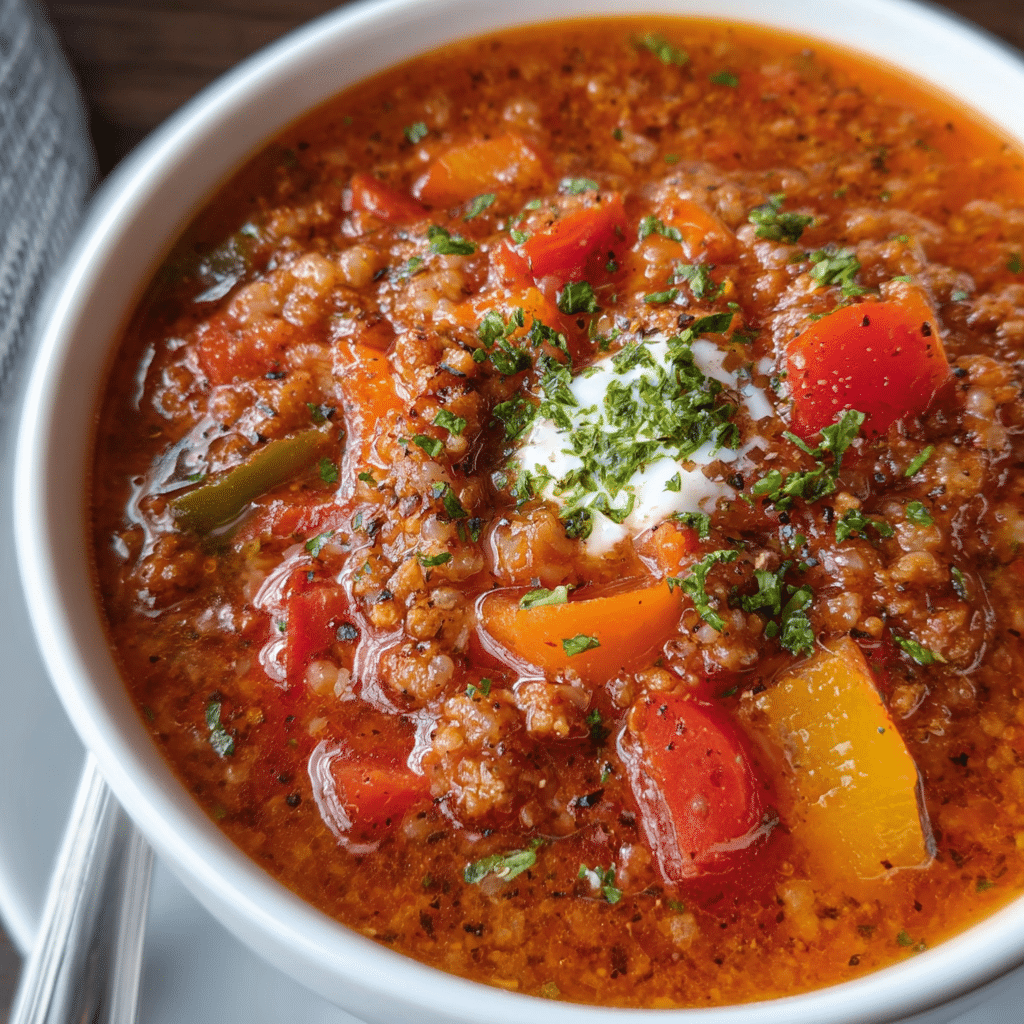
For frozen soup, I recommend thawing it in the refrigerator overnight if possible. However, if you’re short on time, you can reheat it directly from frozen. Just remember that it will take longer to heat through. Start by bringing it to a simmer in a pot over medium heat, stirring frequently, until fully heated. This method ensures the soup maintains its quality and prevents it from becoming too watery.
Additionally, always remember to check the soup’s temperature before serving – it should reach at least 165°F (74°C) to ensure food safety. If you’re reheating a large batch, consider using an immersion blender to give it a quick blend, which can help redisperse any ingredients that may have settled at the bottom during storage.
In summary, mastering the art of storage and reheating for your high protein stuffed pepper soup can turn this delightful dish into a week-long meal solution. By using the right containers, understanding proper freezing techniques, and employing effective reheating methods, you can savor every spoonful without compromising on taste or nutrition. Whether you enjoy it fresh or from the freezer, this soup is sure to be a comforting staple in your kitchen.
Nutritional Benefits and Health Information
As we delve into the nutritional aspects of high protein stuffed pepper soup, it’s important to celebrate not only the delicious flavors but also the wealth of health benefits it offers. With a vibrant mix of ingredients, this soup is a nourishing choice that fits perfectly into various dietary plans. Let’s break down the nutritional profile, health benefits, and dietary considerations of this delightful dish.
Nutritional Profile
At its core, high protein stuffed pepper soup is a hearty blend of bell peppers, lean protein (such as ground turkey or quinoa), tomatoes, and spices. Each ingredient contributes significantly to the soup’s overall nutritional value. A standard serving of this soup can provide around 250-300 calories, depending on the specific ingredients used.
In terms of macronutrients, you can expect approximately:
- Protein: 20-30 grams
- Carbohydrates: 30-40 grams
- Fats: 5-10 grams
This distribution makes the soup an excellent choice for anyone looking to increase their protein intake while keeping a balanced meal. The high protein content is particularly beneficial for muscle repair and growth, making it a favorite among fitness enthusiasts.
Health Benefits
One of the standout features of high protein stuffed pepper soup is its rich array of vitamins and minerals. Bell peppers, for instance, are loaded with vitamin C, an essential nutrient that supports immunity and skin health. They also contain vitamin A, which is crucial for eye health and vision.
Another benefit comes from the inclusion of lean protein sources. If you opt for ground turkey, you’re getting a low-fat, high-protein option that can help with weight management and muscle building. If you choose quinoa, you’ll be adding a complete protein that is also gluten-free, making it a fantastic option for those with dietary restrictions.
In addition to all these nutrients, this soup is also high in fiber, especially if you include beans or whole grains. Fiber plays a key role in digestive health, helping to keep you full and satisfied, which is a bonus for those watching their weight.
Dietary Considerations
As with any dish, it’s important to consider dietary restrictions and allergens. The beauty of high protein stuffed pepper soup is its versatility. You can easily modify the recipe to suit various dietary needs. For instance, vegetarians and vegans can substitute ground meat with lentils or mushrooms, which not only provide protein but also add a depth of flavor.
If you’re following a low-carb diet, you could reduce the amount of rice or omit it altogether, focusing instead on the peppers and protein. For those who are gluten-sensitive, ensure that any grains or packaged ingredients are labeled gluten-free.
Comparatively, when you stack high protein stuffed pepper soup against similar dishes like chili or traditional stuffed peppers, it often comes out ahead in terms of protein content and nutrient density. While chili typically leans heavily on beans and ground beef, this soup allows for a lighter, more vegetable-forward approach. It’s an excellent way to sneak in more veggies into your diet, particularly for picky eaters or children.
In summary, high protein stuffed pepper soup is not just a delicious meal; it’s a nutritional powerhouse that can fit into a myriad of dietary plans. With its rich flavors and numerous health benefits, it’s a dish that can be enjoyed guilt-free. Next time you whip up a batch, take a moment to appreciate not just the taste but also the nourishment you’re providing to yourself and your loved ones.
Frequently Asked Questions About High Protein Stuffed
High protein stuffed pepper soup with rice
To create a high protein stuffed pepper soup with rice, start by selecting a lean protein source such as chicken, turkey, or plant-based options like lentils or quinoa. Cook the protein separately and combine it with diced bell peppers, onions, and garlic in a large pot. Add vegetable or chicken broth, along with your choice of rice, and let it simmer until the rice is tender. For added flavor, incorporate spices like cumin or paprika, and finish with fresh herbs like cilantro or parsley. This recipe is versatile; you can easily adjust the protein content by adding more beans or using a protein-rich rice blend.
High protein stuffed pepper soup with ground beef
For a delicious high protein stuffed pepper soup using ground beef, opt for lean ground beef to keep the dish healthier. Begin by browning the beef in a large pot, then add chopped onions, garlic, and diced bell peppers. After the vegetables soften, stir in diced tomatoes, beef broth, and spices such as oregano and thyme. To boost the protein, consider adding kidney beans or black beans, which also enhance the flavor and texture of the soup. Serve hot with a sprinkle of cheese on top for an extra touch of richness.
High protein stuffed pepper soup low carb
To make a low carb high protein stuffed pepper soup, swap out traditional rice for cauliflower rice or shredded zucchini, which significantly reduces the carbohydrate content while still providing a satisfying texture. Use lean meats such as turkey or chicken, or incorporate plant-based proteins like chickpeas or tempeh for a nutritious boost. Combine diced peppers, onions, and tomatoes in a broth base, and season with herbs and spices to enhance flavor. This soup can be made in advance and stored in the refrigerator, making it an excellent meal prep option for those following a low carb diet.
Easy stuffed pepper soup recipe
An easy stuffed pepper soup recipe starts with browning your choice of ground meat in a large pot, such as turkey or beef. Next, add chopped onions, garlic, and a mix of colorful bell peppers, cooking until softened. Stir in canned diced tomatoes, broth, and your choice of seasonings like Italian herbs or chili powder for a kick. For a quick finish, toss in cooked rice or beans for added texture and protein. This recipe is highly customizable, allowing you to use whatever vegetables or proteins you have on hand, making it perfect for a weeknight dinner.
Conclusion: Mastering the Perfect high protein stuffed
Creating the perfect high protein stuffed is more than just following a recipe—it’s about understanding the techniques, ingredients, and cultural significance behind this beloved dish. Throughout this comprehensive guide, we’ve explored everything from the historical origins to modern variations, ensuring you have all the knowledge needed to make this recipe your own.
Whether you’re a beginner cook or an experienced chef, the techniques and tips we’ve shared will help you create a high protein stuffed that’s not only delicious but also meaningful. Remember that cooking is a journey of discovery, and each time you make this dish, you’ll learn something new.
We encourage you to experiment with the variations we’ve discussed, adapt the recipe to your dietary needs, and most importantly, share it with the people you love. Food has the incredible power to bring people together, and High Protein Stuffed Pepper Soup is the perfect dish to create lasting memories around your dinner table.

